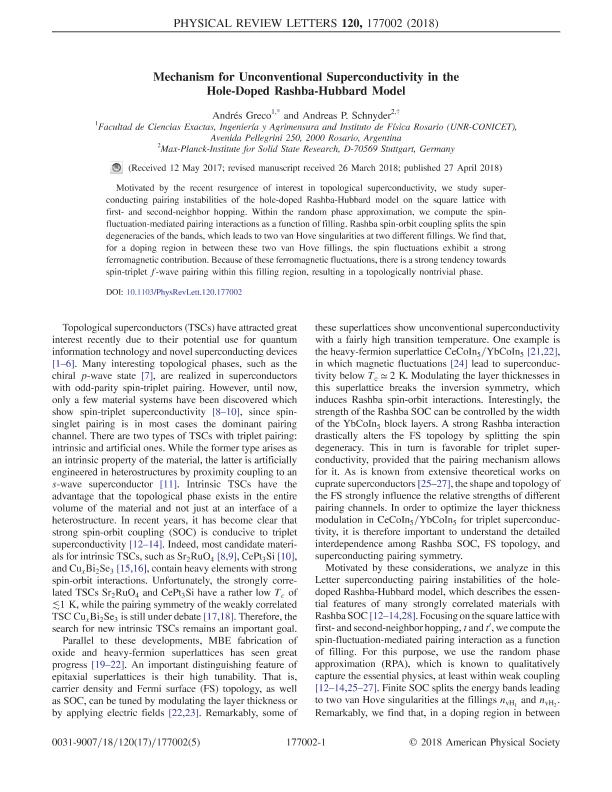Mostrar el registro sencillo del ítem
dc.contributor.author
Greco, Andres Francisco

dc.contributor.author
Schnyder, Andreas P.
dc.date.available
2019-12-12T19:02:29Z
dc.date.issued
2018-04
dc.identifier.citation
Greco, Andres Francisco; Schnyder, Andreas P.; Mechanism for Unconventional Superconductivity in the Hole-Doped Rashba-Hubbard Model; American Physical Society; Physical Review Letters; 120; 17; 4-2018; 1-5; 177002
dc.identifier.issn
0031-9007
dc.identifier.uri
http://hdl.handle.net/11336/92093
dc.description.abstract
Motivated by the recent resurgence of interest in topological superconductivity, we study superconducting pairing instabilities of the hole-doped Rashba-Hubbard model on the square lattice with first- and second-neighbor hopping. Within the random phase approximation, we compute the spin-fluctuation-mediated pairing interactions as a function of filling. Rashba spin-orbit coupling splits the spin degeneracies of the bands, which leads to two van Hove singularities at two different fillings. We find that, for a doping region in between these two van Hove fillings, the spin fluctuations exhibit a strong ferromagnetic contribution. Because of these ferromagnetic fluctuations, there is a strong tendency towards spin-triplet f-wave pairing within this filling region, resulting in a topologically nontrivial phase.
dc.format
application/pdf
dc.language.iso
eng
dc.publisher
American Physical Society

dc.rights
info:eu-repo/semantics/openAccess
dc.rights.uri
https://creativecommons.org/licenses/by-nc-sa/2.5/ar/
dc.subject
SPIN-ORBIT COUPLING
dc.subject
SUPERCONDUCTIVITY
dc.subject
ANTIFERROMAGNETISM
dc.subject
PAIRING MECHANISMS
dc.subject
SPIN-TRIPLET PAIRING
dc.subject
TOPOLOGICAL PHASES OF MATTER
dc.subject
SUPERCONDUCTING ORDER PARAMETER
dc.subject.classification
Física de los Materiales Condensados

dc.subject.classification
Ciencias Físicas

dc.subject.classification
CIENCIAS NATURALES Y EXACTAS

dc.title
Mechanism for Unconventional Superconductivity in the Hole-Doped Rashba-Hubbard Model
dc.type
info:eu-repo/semantics/article
dc.type
info:ar-repo/semantics/artículo
dc.type
info:eu-repo/semantics/publishedVersion
dc.date.updated
2019-12-10T16:49:43Z
dc.journal.volume
120
dc.journal.number
17
dc.journal.pagination
1-5; 177002
dc.journal.pais
Estados Unidos

dc.description.fil
Fil: Greco, Andres Francisco. Consejo Nacional de Investigaciones Científicas y Técnicas. Centro Científico Tecnológico Conicet - Rosario. Instituto de Física de Rosario. Universidad Nacional de Rosario. Instituto de Física de Rosario; Argentina
dc.description.fil
Fil: Schnyder, Andreas P.. Max-Planck-Institute for Solid State Research; Alemania
dc.journal.title
Physical Review Letters

dc.relation.alternativeid
info:eu-repo/semantics/altIdentifier/url/https://link.aps.org/doi/10.1103/PhysRevLett.120.177002
dc.relation.alternativeid
info:eu-repo/semantics/altIdentifier/doi/http://dx.doi.org/10.1103/PhysRevLett.120.177002
Archivos asociados
